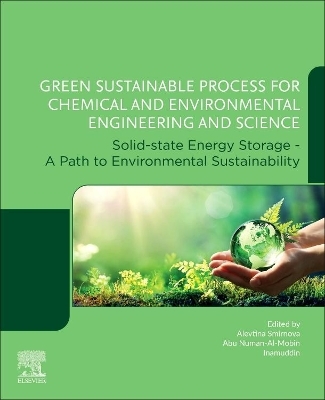
Green Sustainable Process for Chemical and Environmental Engineering and Science
Elsevier - Health Sciences Division (Verlag)
978-0-323-90635-7 (ISBN)
Dr. Smirnova’s research interests are focused on developing efficient and eco-friendly electric power generation and storage devices, such as supercapacitors, fuel cells, and batteries. She authored and co-authored over 200 publications, such as a o book, 13 book chapters, 5 patents, 6 patent applications, and over 180 manuscripts in peer reviewed journals and proceedings. Her research incorporate multi-disciplinary efforts regarding ionic and electronic transport mechanisms in solid and polymer materials, heterogeneous low and high temperature electro-catalysis, and new architectural designs of ionic/electronic conductors and nanocomposites produced by various materials deposition approaches, such supercritical fluids, physical vapor deposition, screen-printing, electron beam, and aerosol ink-jet printing. Research Scientist in the Chemistry, Biology, and Health Sciences Department, South Dakota School of Mines and Technology (SDSMT), USA Dr. Inamuddin, Ph.D, is an assistant professor at the Department of Applied Chemistry, Zakir Husain College of Engineering and Technology, Faculty of Engineering and Technology, Aligarh Muslim University, Aligarh, India. He has extensive research experience in multidisciplinary fields of analytical chemistry, materials chemistry, electrochemistry, renewable energy, and environmental science. He has worked on different research projects funded by various government agencies and universities and is the recipient of awards, including the Fast-Track Young Scientist Award and the Young Researcher of the Year Award 2020 of the university. He has published about 213 research articles in various international scientific journals, 18 book chapters, and 200 edited books with multiple well-known publishers. His current research interests include ion exchange materials, a sensor for heavy metal ions, biofuel cells, supercapacitors, and bending actuators.
1. Next-generation energy storage concepts for environmental sustainability
2. Solid state energy storage: a myth or reality?
3. Lithium-ion solid-state battery market: prospects and forecasts
4. Types of solid-state batteries for the next generation energy storage
5. Major materials challenges in solid-state battery technology
6. Interfacial phenomena in lithium-ion batteries and their observations at nanoscale
7. XPS/AES spectroscopy for evaluation of lithium ion transport at interfaces
8. In-situ/operando methods for investigation of ionic transport mechanisms in solid-state architectures
9. Decision making in battery manufacturing
10. Local degradation phenomena and post-mortem analysis relevant to the next- generation battery technology
11. Ceramic vs. glass-ceramic electrolytes for solid-state batteries
12. Solid-state batteries based on polymer nanocomposites
13. Potential application of sodium ion batteries for electric power grids
14. Solid-state energy storage for EV industry
15. Life cycle analysis for the emerging solid-state battery technology
16. Machine Learning Enabled Computational Screening of materials for the next-generation energy storage
17. Specifics of the battery management systems for solid-state battery technology
18. Problems of lithium dendrite formation in solid-state batteries
19. Composite lithium metal anodes for solid-state battery applications
| Erscheinungsdatum | 03.10.2022 |
|---|---|
| Verlagsort | Philadelphia |
| Sprache | englisch |
| Maße | 191 x 235 mm |
| Gewicht | 450 g |
| Themenwelt | Naturwissenschaften ► Chemie ► Technische Chemie |
| Technik | |
| ISBN-10 | 0-323-90635-4 / 0323906354 |
| ISBN-13 | 978-0-323-90635-7 / 9780323906357 |
| Zustand | Neuware |
| Haben Sie eine Frage zum Produkt? |
aus dem Bereich


